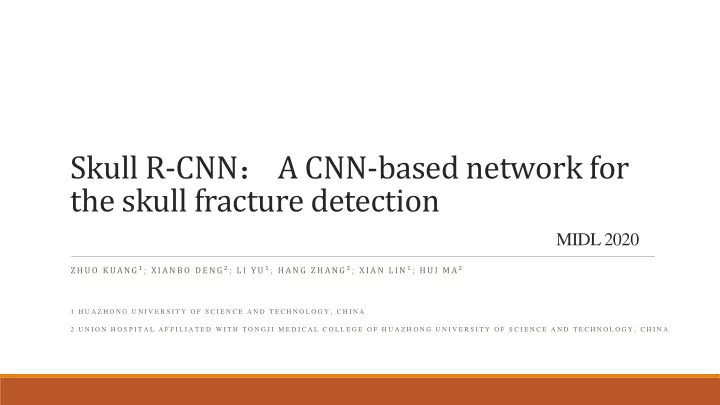

Skull R-CNN : A CNN-based network for the skull fracture detection MIDL 2020 Z H U O K UA N G 1 ; X I A N B O D E N G 2 ; L I Y U 1 ; H A N G Z H A N G 2 ; X I A N L I N 1 ; H U I M A 2 1 H U A Z H O N G U N I V E R S I T Y O F S C I E N C E A N D T E C H N O L O G Y , C H I N A 2 U N I O N H O S P I T A L A F F I L I A T E D W I T H T O N G J I M E D I C A L C O L L E G E O F H U A Z H O N G U N I V E R S I T Y O F S C I E N C E A N D T E C H N O L O G Y , C H I N A
Background Content Method Experiment results
Background
Background Figu Figure. 1. . The skull fractures annotated by the radiologist. The blue boxes are the ground truth annotated by the radiologists, which contain the fractures.
Background The fractures usually present as narrow slits; The locations and the length of fractures are diverse; A considerable percentage of the fractures have very small sizes; Fig Figure. 2. 2. The distribution of the width and length of the object boxes.
Method
Skull R-CNN 64*512*512 Full resolution 64*256*256 Classification Proposal Layer feature network Regression Roi Align 64*128*128 Skeleton-based Region Proposal Feature Maps Coordinates Fig Figure. 3. 3. The architecture of the Skull R-CNN
Skeleton-based region proposal Based on the origin CT image Based on the feature map with low resolution D A B C Fig Figure. 4. 4. Le Left: Region proposal network(RPN)[1]; Righ Right: Skeleton-based region proposal The candidate boxes are much less than RPN, while keeping enough boxes containing fractures. Compared to RPN, there is no need to be trained and it just costs small amount of computation . 1. Shaoqing Ren, Kaiming He, Ross Girshick, and Jian Sun. Faster r-cnn: Towards real- time object detection with region proposal networks. In Advances in neural information processing systems, pages 91 – 99, 2015.
Full resolution feature network Prediction 512 64*512*512 512*512 512 512*512 512 Inut image 512 12 12*512 12*51 64*512* 64*512 64*512 1*512* *512 64*5 64* 64* 1*5 64 The output feature maps have higher resolutions than the *256 *256 Prediction *256 128*256*256 256 256 256*256 256 256*256 *256*25 *256*25 56*25 FPN[2], and have more accurate local information; 128*256 *256 64*256 64*256 128*25 128*25 64*2 64* 64* 128 128 64 Compared to FPN[2], element-wise addition is replaced by the concatenation to softly merge the feature maps . Prediction *128 28 *128 28 *128 *128 *128 128*128 128 *128*12 *128*12 *128*12 128*1 128*1 64*128 8*12 6*12 256*12 256*12 128*12 128* 256* 64* 256 256 128 12 25 Conv(3*3+BN+ReLu) 256*64*64 64 64 *64*64 Conv(1*1+BN+ReLu) 256*64* 256*64 Upsampling(by2) 256 Max-pooling(by2) Max Fig Figure. 5. 5. The structure of the full resolution feature network. 2.Lin T Y , Dollár, Piotr, Girshick R , et al. Feature Pyramid Networks for Object Detection[J]. 2016.
Experiment results
Objective indices Tab able. 1. . The performance of the models. AP( × 0.01) Methods Detection time(s\slice) val test val(<16*16) test(<16*16) val test Faster R-CNN + FPN 55.7 54.2 59.4 49.3 0.088 0.087 Skull R-CNN + FPN 62.6 57.9 64.7 58.6 0.058 0.058 Skull R-CNN 65.1 60.0 67.3 63.3 0.035 0.036 Fig Figure. 6. 6. The PR curves on the test set. Le Left: Faster R-CNN+FPN; Righ Right: Skull R-CNN
Subjective results Fig Figure. 7. 7. The detection results of the Skull R-CNN. The images in the second row are the partial magnifications of images in the fist row. In which, the green boxes are TP predictions, the red boxes are FP predictions, and the blue boxes are the FN predictions
Thank you for listening !
Recommend
More recommend